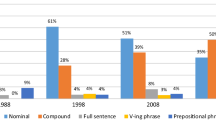Abstract
This study aims to investigate different types and trends of information provided by research titles published in the applied linguistics journals from 1975 to 2015. To this end, 428 research titles published in 63 issues of three applied linguistics journals, namely, Modern Language Journal, Language Learning, and Foreign Language Annals were extracted. The research titles were analyzed for the information they contained in terms of such categories as Method/Design, Result, Dataset, and Conclusion. The results revealed that from 1975 to 2015, the research titles of the three applied linguistics journals tended to provide the most information on Method/Design of the studies. In addition, the research titles containing information on Topic, Result, and Dataset showed fluctuating rates in different time intervals. However, the research titles containing information about Conclusion had a falling rate in the three journals. The study concludes with some discussion on the results obtained.








Similar content being viewed by others
References
Ary, D., Jacobs, L. C., Sorensen, C. K., & Walker, D. (2014). Introduction to research in education (9th ed.). London: Wadsworth.
Baicchi, A. (2003). Relational complexity of titles and texts: A semiotic taxonomy. In L. Merlini Barbaresi (Ed.), Complexity in language and text (pp. 319–341). Pisa: PLUS.
Ball, R. (2009). Scholarly communication in transition: The use of question marks in the titles of scientific articles in medicine, life sciences and physics 1966–2005. Scientometrics, 79(3), 667–679. doi:10.1007/s11192-007-1984-5.
Beel, J. & Gipp. B. (2009). Google Scholar’s ranking algorithm: An introductory overview. In Proceedings of the 12th International Conference on Scientometrics and Informetrics 1, (pp. 230–241).
Busch-Lauer, I. (2000). Titles in English and German research papers in medicine and linguistics. In A. Trosborg (Ed.), Analysing professional genres (pp. 77–97). Amsterdam: John Benjamins.
Buxton, A. B., & Meadows, A. J. (1977). The variation in the information content of titles of research papers with time and discipline. Journal of Documentation, 33(1), 46–52.
De Swert, K. (2012). Calculating inter-coder reliability in media content analysis using Krippendorff’s Alpha. Retrieved October 10th, 2015, from http://www.polcomm.org/wpcontent/uploads/ICR01022012.pdf.
Forray, J. M., & Woodilla, J. (2005). A discourse analysis of temporality in journal titles. Time and Society, 14(2/3), 323–339.
Fox, C. W., & Burns, C. S. (2015). The relationship between manuscript title structure and success: Editorial decisions and citation performance for an ecological journal. Ecology and Evolution, 5(10), 1970–1980.
Gesuato, S. (2009). Encoding of information in titles: Practices across four genres in linguistics. In C. Taylor (Ed.), Ecolingua: The role of e-corpora in translation and language learning (pp. 125–157). Trieste: EUT.
Goodman, R. A., Stephen, B. T., & Paul, Z. S. (2001). What’s in a title? A descriptive study of article titles in peer-reviewed medical journals. Science Editor, 24(3), 75–78.
Haggan, M. (2004). Research paper titles in literature, linguistics and science: Dimensions of attractions. Journal of Pragmatics, 36(2), 293–317.
Hartley, J. (2008). Academic writing and publishing: A practical handbook. Abingdon: Routledge.
Jacques, T. S., & Sebire, N. J. (2010). The impact of article titles on citation hits: An analysis of general and specialist medical journals. JRSM Short Reports, 1(1), 1–5.
Jalilifar, A. R. (2010). Writing titles in applied linguistics: A comparative study of theses and research article. Taiwan ESP Journal, 2(1), 27–52.
Kumar, M. J. (2013). Making your research paper discoverable: Title plays the winning trick. IETE Technical Review, 30(5), 361–363. doi:10.4103/0256-4602.123113.
Laurence, A. (2001). Characteristic features of research article titles in computer science. IEEE Transactions on Professional Communication, 44(3), 187–194.
Lewinson, G., & Hartley, J. (2005). What’s in a title? Number of words and the presence of colons. Scientometrics, 63(2), 341–356.
Nagano, R. L. (2015). Research article titles and disciplinary conventions: A corpus study of eight disciplines. Journal of Academic Writing, 5(1), 133–144.
Nord, C. (1995). Text-functions in translation: Titles and headings as a case in point. Target, 7(2), 261–284.
Rath, A. (2010). A discourse analysis of first position nominal groups in research article titles. Taiwan International ESP Journal, 2(1), 85–104.
Rostami, F., Mohammadpoorasl, A., & Hajizadeh, M. (2013). The effect of characteristics of title on citation rates of articles. Scientometrics, 98(3), 2007–2010.
Roy, M. (2008). Du titre littéraire et de ses effets de lecture. Protée, 36(3), 47–56.
Salager-Meyer, F., & Alcazar-Ariza, M. A. A. (2013). Titles are “serious stuff”: A historical study of academic titles. JAHR, 4(7), 257–271.
Siegel, P. Z., Thacker, S. B., Goodman, R. A., & Gillespie, C. (2007). Titles of articles in peer-reviewed journals lack information on study design: A structured review of contributions to four leading medical journals, 1995–2001. Science Editor, 29(6), 183–185.
Soler, V. (2007). Writing titles in science: An exploratory study. English for Specific Purposes, 26(1), 90–102.
Soler, V. (2011). Comparative and contrastive observations on scientific articles written in English and Spanish. English for Specific Purposes, 30(1), 124–137.
Swales, J. (1990). Genre analysis: English in academic and research settings. Cambridge: Cambridge University Press.
Wang, Y., & Bai, Y. (2007). A corpus-based syntactic study of medical research article titles. System, 35(3), 388–399.
Whissell, C. (1999). Linguistic complexity of abstracts and titles in highly cited journals. Perceptual and Motor Skills, 88(1), 76–86.
Whissell, C. (2013). Titles in highly ranked multidisciplinary psychology journals 1966–2011: More words and punctuation marks allow for the communication of more information. Psychological Reports, 113(3), 969–986. doi:10.2466/28.17.PR0.113x30z5.
Yakhontova, T. (2002). Titles of conference presentation abstracts: A cross-cultural perspective. In E. Ventola, C. Shalom, & S. Thompson (Eds.), The language of conferencing (pp. 277–300). Frankfurt: Peter Lang.
Yitzhaki, M. (1994). Relation of title length of journal articles to number of authors. Scientometrics, 30(1), 321–332.
Author information
Authors and Affiliations
Corresponding author
Appendix
Rights and permissions
About this article
Cite this article
Sahragard, R., Meihami, H. A diachronic study on the information provided by the research titles of applied linguistics journals. Scientometrics 108, 1315–1331 (2016). https://doi.org/10.1007/s11192-016-2049-4
Received:
Published:
Issue Date:
DOI: https://doi.org/10.1007/s11192-016-2049-4



